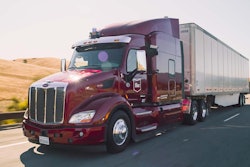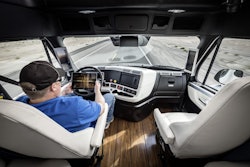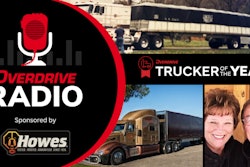Paul Schlegel of Starsky Robotics, the company’s senior vice president of trucking operations, joined Pronto.ai’s co-founder Ognen Stojanovski in a panel at the Great American Trucking Show with something of a provocative subject at its heart: the driver’s role with the “driverless” trucks of the future. The discussion came nearing the end of a federal comment period on autonomous truck technologies and whether the regulatory environment needed adjustment to account for testing and operation on public roads. That comment period closes August 28.
Moderated by Overdrive Equipment Editor/CCJ Editor Jason Cannon, one of the panel’s central themes was voiced early on by Stojanovski: The reality that, as he put it, “there is no software that has the experience and instincts that a driver has.”
Stojanovski repeated such perspective throughout the talk, a dose of skepticism about the place where the science behind autonomous driving techs is today, and its ability to enable engineered products that truly replace any driver. His company’s CoPilot product is a Level 2 driver-assist technology that combines features like fully adaptive cruise control, lane-keeping, auto-braking capability and other techs in a package capable of being retrofit to truck-tractors.
Schlegel and Starsky Robotics, meanwhile, have taken a different approach toward autonomous truck development. While the company’s headquarters is in San Francisco, Starsky trucking operations are centered in Dallas, where Starsky operates a 45-truck fleet, with just three units outfitted with the multiple on-vehicle cameras and radar systems that underpin its remote-driver model.
Starsky’s a trucking company, looked at in the simplest terms, with an approach to building its autonomous technology by focusing testing of the three trucks (a fourth is in development) on short lanes with predictable freight. Those three trucks while in testing are operating by not one, but two drivers deployed to each truck.
“When I [first] looked at autonomous,” Shlegel said, “I thought, ‘That’s a long ways off’ – autonomous in a commercial setting coast to coast for all lanes is a long, long, long ways off.”
The focus on short lanes reflects an approach to building technology that centers on what Schlegel believes is achievable today: eliminating as many of the variables on a particular, dedicated lane as possible, allowing a safety driver inside the truck and a remote “tele-ops” driver in an office location with 360-degree views of the road to jointly “identify any problem” en route. That happens, Schlegel added, in tandem with the machine learning portion of the trucks’ technology. “Our approach doesn’t rely solely on machine learning. … We want to be able to operate on repeatable lanes in Texas and Florida,” two states whose rules on unmanned vehicles are permissive to testing this kind of technology. Eventually, Starsky hopes to run freight in partially autonomous vehicles “across the I-10 corridor.”









